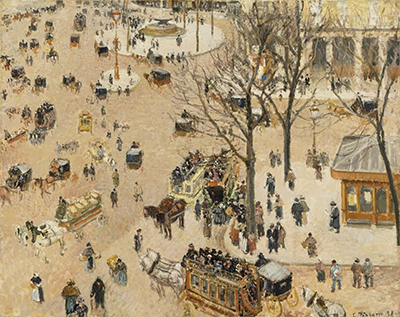When Pissarro started this artwork, it was in his darkest year. His son Lucien suffered a stroke while another son, Felix died of tuberculosis at a tender age of 23. Himself, he was still suffering from an eye infection that started back in 1889. In 1897 Pissarro began to draw a series of 15 pictures of views from the Grand Hotel du Louvre in Paris.
The images were aimed at showcasing the various scenes from the Avenue de l’Opera, the Place du Theatre Francais to the rue St Honore. He finished drawing the series in 1898, one of which was the La Place du Theatre Francais. This time was also characterized by political instability, which much divided Impressionists. One of his friends who separated from him was Degas who became strongly anti-Semitic, yet Pissarro was Jewish. To get through this tough time, Pissarro buried himself in his work, keeping his art separate from politics even though he was very political.
In one of his letters to Felix he states that he is happy to paint the streets of Paris even though they are often referred to as ugly yet they are luminous, silvery and lively. One of these paintings he talks about is this one. In this piece, the Place du Theatre Francais is in the foreground. This is from where Avenue del l’Opera branches off. At the very end, Charles Garnier's opera house can be seen, with a haze enclosing it. There are high end shops filling the city.
The streets are painted looking wet from the rains. The work involves views from a distance that are plunging ion to perspective. Pissarro was interested in depicting the everyday life of the city not the famous views. The tiny human figures, the traffic and the fresh leaves of trees in spring season are well painted in differentiated strokes. He captured the atmosphere and the sunlight to bring a vivid picture.
Authors That Inspired his Work
Paul Cezanne was a French artist and a post-impressionist painter, with his work laying the transit foundation from the 19th to the 29th Century world of art. Pissarro and Cezanne met in Paris where their friendship started in mid 1860s. Pissarro at that time was extending his informative influence on younger artists making Cezanne his disciple. Over the decades of painting excursions together in Pontoise and Louveciennes, they became equals and even collaborated in paintings. Cezanne main paintings were also on landscapes where in some he included large and heavy figures.
Paul Gauguin was also a post-impressionist artist from French. His work however involved color and synthetic style that was however distinct from that of impressionists. He began painting in his free time in 1873, after he became a stock broker. He became friends with Pissarro and went to visit him on Sundays while painting his garden. Through Pissarro, he met other artists. In 1882, the stock market crashed, leading to Gauguin formulate being a fulltime artist for two years after which he joined Pissarro for the two summers that followed and occasionally painted with Cezanne too.




